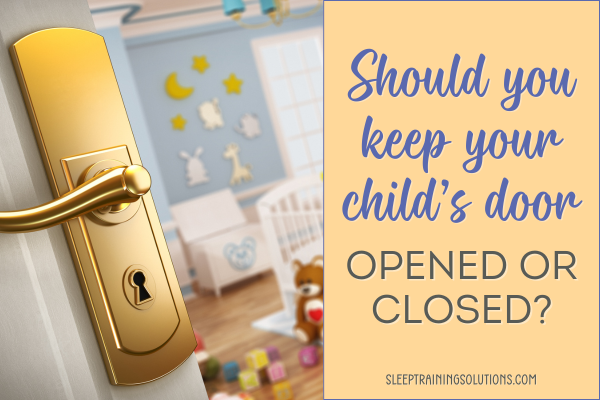Should You Leave Your Child’s Door Open or Closed?
Should You Close Your Child’s Bedroom Door at Night?
Ah, the great bedtime debate—should you leave your child’s door open or closed at night? It’s a surprisingly loaded question with strong opinions on both sides. Some parents prefer to keep the door wide open so they can hear every sound, while others insist on a fully closed door to create the perfect sleep environment. But which approach is truly best for your child’s sleep, safety, and overall well-being?
In this post, we’ll break down why kids often want their door open, the benefits (and risks) of keeping it closed, and even some middle-ground solutions that can give you the best of both worlds.
Why Your Child Wants Their Door Open
If you’ve ever tried to close your child’s door at bedtime, you’ve probably heard the familiar “Don’t close the door!” Why the obsession with an open door? Here are a few reasons:
🟡 Fear of the Dark
The feeling of having the door fully closed can sometimes make kids feel a little uneasy or alone. Leaving the door slightly cracked lets in just enough light to give them a sense of comfort and security while still keeping things cozy for sleep.
🟡 Separation Anxiety
Young children often experience separation anxiety, especially at bedtime when they’re left alone. An open door provides a sense of connection—they can still hear the hustle and bustle of the house, giving them comfort that they’re not entirely alone.
🟡 FOMO (Fear of Missing Out)
FOMO for toddlers is real! If they hear laughter or conversation coming from the living room, they may feel left out and want to keep the door open to stay somewhat “in the loop.”
🟡 Control and Autonomy
As kids grow, they begin asserting their independence. Keeping the door open is often one of those small battles where they feel a sense of control over their environment. It’s their way of saying, “I’m in charge here, not YOU!”
Why It’s Better to Close the Door at Night
While an open door may seem harmless (and an easy way to avoid a meltdown), closing the door at night offers several significant benefits—for both sleep quality and safety.
✅ 1. A Dark Room Promotes Better Sleep
Sleep experts agree that complete darkness is ideal for quality sleep. Darkness signals the brain to produce melatonin, the hormone that helps regulate sleep. Even a sliver of light creeping through a cracked door can disrupt this process, leading to fragmented sleep or difficulty falling back asleep if your child wakes in the middle of the night.
💡 Pro Tip: If your child insists on a nightlight, opt for a dim, warm-colored light rather than something bright or blue-toned like this one that automatically shuts off during the day and turns back on at night!
✅ 2. Reduced Noise and Fewer Distractions
When the door is left open, household noises—like dishes clanking, conversations, the tv or even a flushing toilet—can filter into your child’s room and wake them up. A closed door creates a barrier that muffles these sounds, giving them a quieter, more peaceful environment…especially in that lighter sleep before they fall into deeper sleep.
✅ 3. Safety First: A Barrier in Case of Fire
This one is non-negotiable. According to the National Fire Protection Association (NFPA), a closed door can slow the spread of fire, giving everyone in the home more time to escape safely. A closed door can also reduce smoke inhalation and heat exposure—potentially saving lives.
🔥 Fact: Studies show that rooms with closed doors can be up to 900 degrees cooler than those with open doors during a fire.
✅ 4. Preventing the “Give an Inch, They Take a Mile” Game
Here’s where things get tricky. If you give in and leave the door slightly cracked, your child may quickly push the boundaries. Tonight, they want it open a little—tomorrow, they’ll want it all the way open. It’s a slippery slope that can lead to a constant tug-of-war over bedtime routines.
💡 Parenting Tip: Establish a consistent rule about door position at bedtime, and stick to it. Consistency helps kids know what to expect and minimizes negotiating tactics.
There are so many pieces to successfully sleep training - Download your free PDF and get weekly sleep tips to help set you up for success!
Why You Might Leave the Door Open
That being said, there are a few legitimate reasons why keeping the door open may be necessary (or at least worth considering).
🔊 1. No Baby Monitor? You Need to Hear Them
If your child is young and you don’t have a baby monitor, an open door allows you to hear them if they wake up, cry, or need help during the night. This is especially important if they’re sick or prone to night wakings.
🚽 2. Potty Training or Bathroom Access
If your child is newly potty trained and still navigating nighttime bathroom trips, an open door gives them easy access to the bathroom without fumbling in the dark. It’s a small change that can prevent unnecessary accidents and frustration.
😰 3. If Closing the Door Triggers Severe Anxiety
For some kids, closing the door isn’t just about preference—it’s about genuine anxiety. If closing the door leads to extreme fear or panic, it’s okay to compromise while gradually working toward a closed door over time.
💡 Gradual Approach: Try leaving the door slightly cracked and reduce the opening by an inch every few nights until it’s fully closed. This helps ease the transition without causing distress.
🎧 White Noise Machines in the Hallway
In addition to placing a white noise machine inside your child’s room, consider placing one outside the door. This drowns out household noise while maintaining a sense of connection for kids who prefer the door open.
Two Products That Can Help
🛑 1. Door Draft Stopper for Light and Sound Control
If your child’s door has a gap at the bottom, light and noise can easily sneak in, even if the door is technically closed. A door draft stopper like this blocks light and sound, creating a more serene sleep environment while allowing the door to remain securely shut, and doesn’t mess up the paint with adhesive.
🚪 2. Door Cover for Bright Hallway Light
If your hallway is brightly lit (opens into a great room with windows or has a skylight right above the door) or you need to keep a light on for safety reasons, a door cover can diffuse the brightness while still allowing some visibility. Using a cover like this one, you can slip behind it before opening the door to help keep the light out. This is especially helpful during sleep training if you’re doing a method with check ins and/or for early morning wakeups.
Final Verdict: Keep Your Child’s Bedroom Door Open or Closed?
Ultimately, the decision to leave your child’s door open or closed at night depends on your child’s needs, your home setup, and safety considerations. However, if safety and quality sleep are your top priorities, a closed door is almost always the best option. It protects your child in emergencies, minimizes noise disruptions, and promotes better rest.
But if a fully closed door causes stress or anxiety for your child, finding creative compromises can help bridge the gap without sacrificing safety or routine.
☑️ Keep in mind that after you transition your child from a crib to a bed, I recommend keeping the door closed. The freedom of now having an open bed, on top of an open door is just an invitation to explore at 2am for for children!
Whatever you decide, consistency is key. Stick with your bedtime decision, and your child will adjust over time—leading to smoother nights for everyone.
If bedtime feels like a never-ending battle because your child insists on keeping the door open (and the tantrums just won’t stop), I can help! Schedule an evaluation call, and let’s chat about how I work with families in situations just like yours to bring calm and consistency back to bedtime. You don’t have to do this alone—I’ve got you!
Should You Leave Your Toddler’s Door Open or Closed?
Related Posts:
This post is for informational purposes only and may not be the best fit for you, your child and/or your personal situation. It shall not be construed as medical advice. The information and education provided here is not intended or implied to supplement or replace professional medical treatment, advice, and/or diagnosis. Always check with your child’s physician or medical professional before trying or implementing any information read here.
Sleep Training Solutions is a participant in the Amazon Services LLC Associates Program, an affiliate advertising program designed to provide a means for sites to earn advertising fees by advertising and linking to Amazon.com and affiliated websites. I will earn a small commission, at no additional cost to you, if you purchase them.






